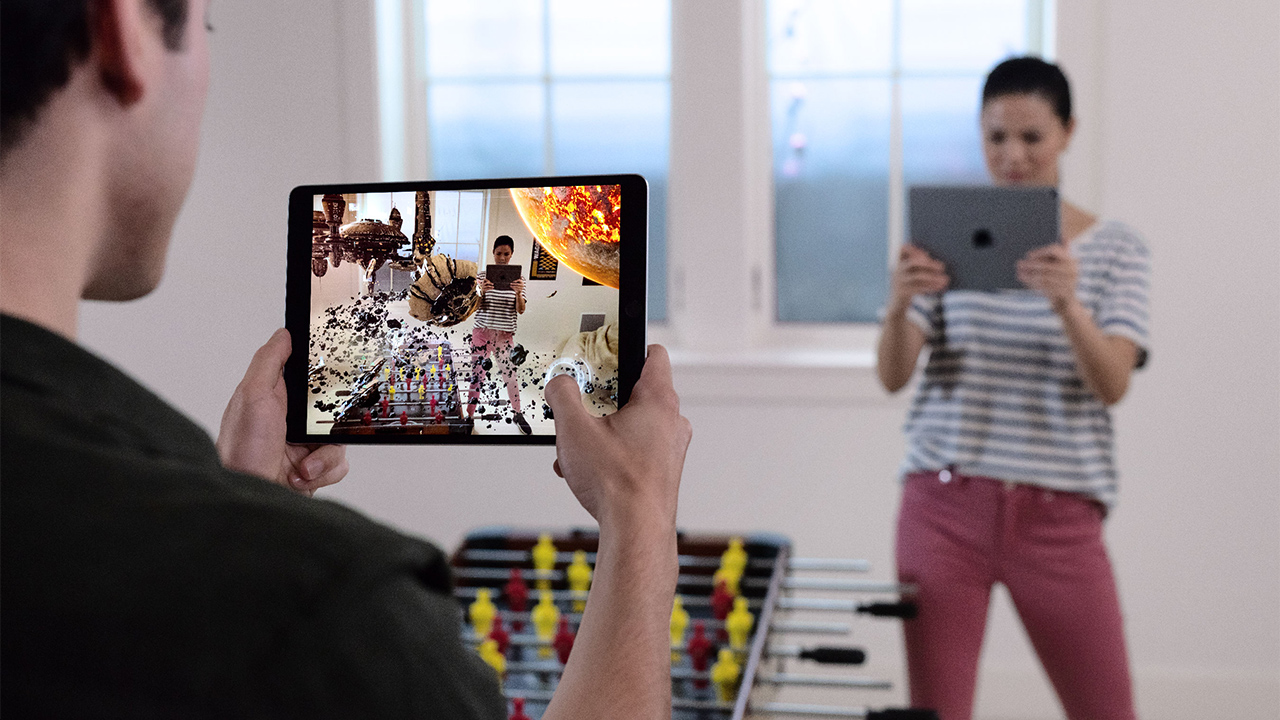
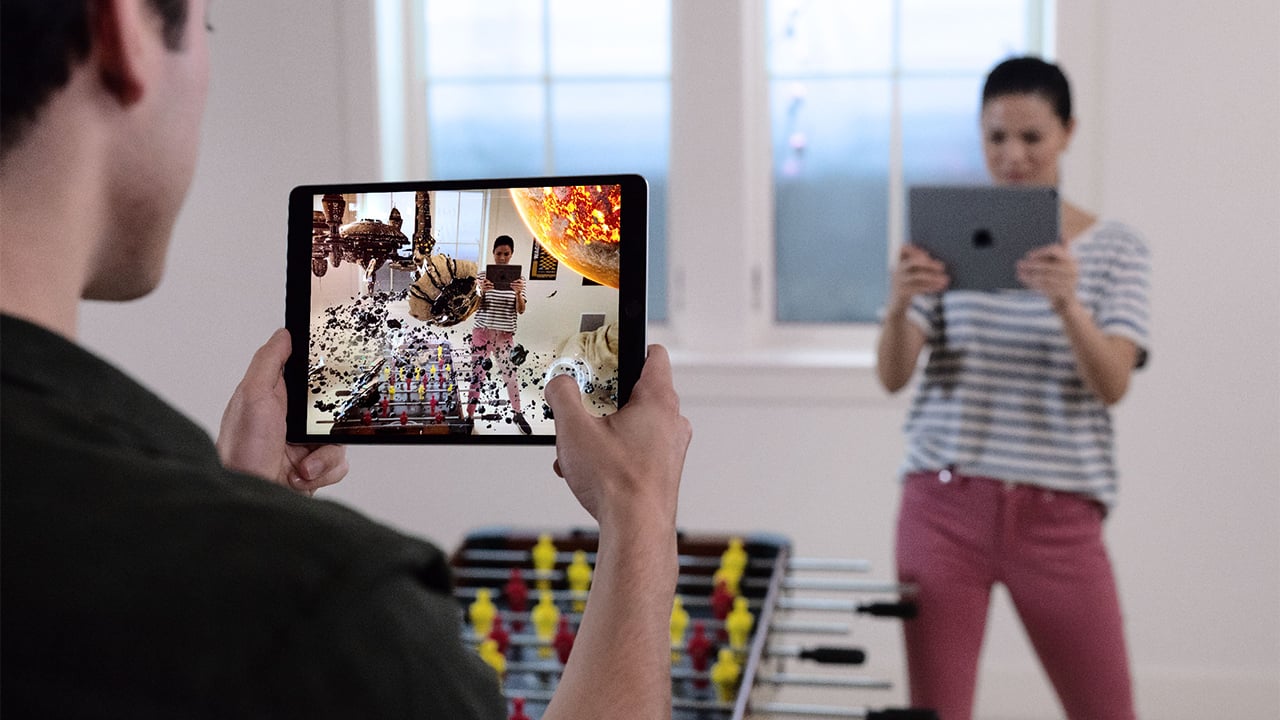
In what was perhaps not the event filled with earth shattering announcements many were predicting, at this years WWDC Apple introduced advanced functionality to enhance workflows for both Mac and iOS, along with more unity, including running iOS apps on macOS.
Although primarily aimed at developers, WWDC18 has frequently served as a platform for launches such as new MacBooks and iPad Pros, but that wasn’t to be this year.
This year went by the book with all the focus on the 2018 iterations of watchOS, tvOS, iOS and macOS. Developer builds are already available and public betas usually follow, with the full release in the Autumn around the time new iPhones ship.
As had been leaked months ago, Apple’s focus in 2018 is on stability above all - a Snow Leopard style focus on streamlining code and reliability rather than grand new features.
So this wasn’t a WWDC to wow consumers. The ultra-wide stage featured a superbly presented video backdrop, cameras swooped and panned with slick video sequences interspersed, but the content was mostly low key.
There was no ‘one more thing’ hardware launch, but there was still a clever theatrical reveal to end with. Craig Federighi squarely faced up to rumours about macOS and iOS merging and bluntly refuted that any such thing would happen.
But then as the animated dust settled, he officially revealed the initiative we’ve covered before: technology to make it much easier to port iOS apps onto macOS.
The Frankenstein nature of Android apps on ChromeOS have given this concept a very bad reputation, but threaded through the two hour plus presentation were enhanced iOS apps - News and Stocks - plus Voice Memo and Home which were all coming to Mac for the first time. These obviously aren’t the most heavyweight apps around, but their careful presentation earlier showcased them as attractive, full-screen native Mac apps that looked absolutely first class.
So phase I of this project is Apple ‘dog-fooding’ the process with its own apps prior to providing the polished technology to app developers in 2019.
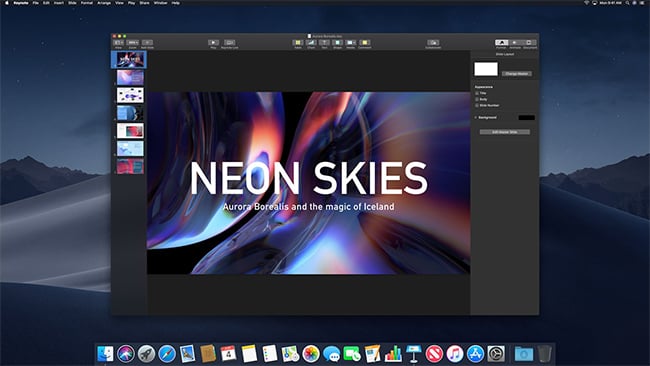
Dark mode is one of the new features of the forthcoming macOS update Mojave
macOS Mojave
Any paranoia about this technology side-lining the Mac was comprehensively ameliorated by the Mac being an unexpected star of this particular WWDC.
Tim Cook rather oversold it with ‘professional features coming to consumers’ and a ‘huge’ step forward, but this was a rare occasion when the Mac closed out the show with a set of enhancements that weren’t simply last year’s iOS features.
Dark Mode has long been on the iOS wish list, but Mac gets it first and sold in as ideal for professional photographers. The demo showed off Calendar, Mail and Xcode in dark mode to impressive effect.
There’s also a dynamic desktop mode which subtly changes during the day - and while that seemed familiar, we also got desktop stacks that automatically group anything dropped there into groups as you prefer - e.g. file type, date etc.
Finder gets a gallery view, similar to Cover Flow but with much more focus on the dominant file type image. There’s also contextual quick actions, so you can rotate a photo or even trim audio/video in Finder itself, plus the option to customise quick actions to suit your workflow. One obvious example being to watermark a photo with your logo via a single click in Finder.
These kind of features have been available before through third-party apps of course, but integration into the OS is welcome.
In terms of innovation, there was an intriguing demo of screen capturing a live video and dropping directly into a document. Continuity video allowed for an iPhone to be powered on as a camera source with a single click as well as an option for directly scanning in a file.
There was also a tantalising showing of Epic’s Day of the Dead photorealistic graphics demo running in real time on a MacBook Pro using an eGPU.
Apple also shared the latest development in its Machine Learning initiatives, including a new app called Create ML enables users to benefit from machine learning for vision and natural language, as an example, without being experts simply by using Swift.
We also received a first look at the rejuvenated Mac App Store with a slick new look reminiscent of the excellent iOS App Store, with integrated preview videos and editorial content. The Mac App Store has faltered over recent years due to rigid sand boxing limiting app functionality, alongside an inflexible pricing policy that made upgrade fees difficult. So just as impressive as the visuals was news of Microsoft (Office 365), Panic (Transmit), Lightroom CC (Adobe) BBEdit (Bare Bones Software) and more coming aboard as a reversal of the steady desertion we’ve seen previously.
Sadly, there was no MacBook Pro with Intel’s six-core i7-8750H and 32GB of DDR4 RAM. Not yet, at least, but professional Mac users can feel optimistic about what’s to come.
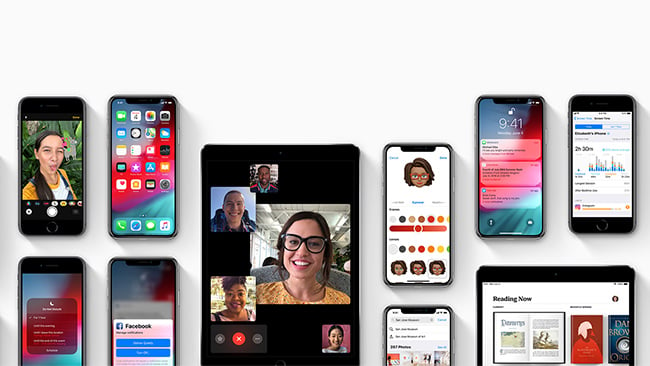
iOS 12 promises huge speed boosts, even on older phones such as the 5S
iOS 12
The focus is on speed and stability with target devices being exactly the same as iOS 11. Although internally stability and reliability is key, the presentation focused on speed with bold claims for performance improvements on an iPhone 6: apps launching up to 40% faster.
Federighi suggested speed alone was enough to justify iOS 12, but of course there were some new features with ARKit 2 demonstrating impressive shared experiences with multiple people viewing the same scene using individual devices.
One example showed two people launching a ball at each other’s wooden block defences. It looked a fun demo, which will come included for developers today. There was also a simple Measure app that mimicked the functionality of the third-party MeasureKit iOS app.
An extensive Lego demo showed a real play-set being extended out in AR and providing an environment for up to four people to explore with their Lego characters. An amusing firefighting exercise included a helicopter and a neat ‘save’ animation where the virtual toys disappeared into the physical set. That said, as with almost all AR apps, however light an iPhone or iPad might be, it’s not going to provide the convenience or field of view possible with dedicated AR glasses (something Apple is more aware of than anyone, of course).
We shouldn’t forget that Pokemon Go has already provided Apple with a monster AR hit, but right now it seems the exception to the rule of AR being mainly for keynote demo’s rather than practical utility.
Apple also introduced a new file type specifically developed with Pixar for AR. USDZ (universal scene description) allows for the integration of all sorts of data from video to 3D objects into AR. An example given was a book with an illustration of a fish. Using the new file type, you could open this illustration up into 3D and explore its animation. An Adobe VP appeared on stage to say the company was ‘all in’ on this format with full support via Creative Cloud so PhotoShop CC and Dimension CC can directly export to the format for use on iOS devices. Adobe are also working on new authoring tools with its Project Aero.
By comparison, updates for the News app (side bar) and iBooks (renamed Apple Books) had limited stage time. iOS notifications will also receive an update with grouped notifications receiving particularly enthusiastic applause.
Siri Retuned
We’ve previously heard about Siri automatically suggesting apps based on its observation of your daily routine. In iOS 12 that will be extended, one example being Siri prompting you with an order for your favourite coffee at the appropriate time in the morning.
Siri is also being opened up with third-party app access using something called Siri Shortcuts. Open up a compatible third-party app and you’ll be prompted to enable a short cut so Siri has access to that app’s functionality.
The underlying technology isn’t limited to Siri and looks to be Apple’s reworking of the Workflow app is acquired in March 2017. Designed to string together various apps and tasks using drag and drop functionality, it’s now been re-imagined by Apple.
One workflow demo’d was ‘going home’ which showed a string of actions invoked with a single click; maps for directions home, favoured radio station on, home thermostat adjusted and fan turned on. The examples on show were very lightweight and consumer oriented, but the potential on iPad Pro’s will be interesting to test.
Taking control
There’s been a lot of concern about screen time, particularly for children, and it was impressive to see Apple engaging so comprehensively in this area. The approach pivoted on insight and control, with the former providing a visually attractive overview of how much you’ve used your iOS device during the day, which apps and so on. Following on from this, there’s comprehensive control options so you can put limits on certain apps - Instagram was a showcase for a timer with reminders of how much time you’ve allocated yourself. It’s easy enough to override the limit if you choose, but it’s a helpful, attractive tool. Plus there’s the option to impose limits on children in a family and the granularity of control seemed well thought out.
Back on the fun side, we had Memoji which allowed for extensive customisation of 3D emoji to provide your own personal avatar. Hair style, colour, eye colour, skin colour, glasses etc. Etc. The personalisation was impressive, while the real-time 1-to-1 animation of Memoji to mirror your facial expression looked superb.
This was all taken up the next level with FaceTime being upgraded for group calls with up 32 people, all of whom could use Memoji. In group FaceTime, there’s a roster of faces at the bottom that scrolls through all participants, plus more prominent tiles at the top of the screen for active participants. Quite what bandwidth is needed to make it work as smoothly as in the demo wasn’t addressed...
tvOS 12
The big news here was Dolby ATMOS. Apparently Apple TV will be the only streaming box with ATMOS Vision and Audio, while iTunes will host the largest collection of ATMOS content anywhere plus, as before with 4K HDR, any existing content you have that becomes available in ATMOS will be upgraded for free. In addition to content deals, Apple’s working hard to bring onboard cable operators such as Canal+ and Charter Spectrum who’ll offer Apple TV instead of a cable box, with a particularly nice feature being zero-sign-in. On those supported cable networks, Apple TV can automatically grab your subscription details and activate them without any sign in at all.
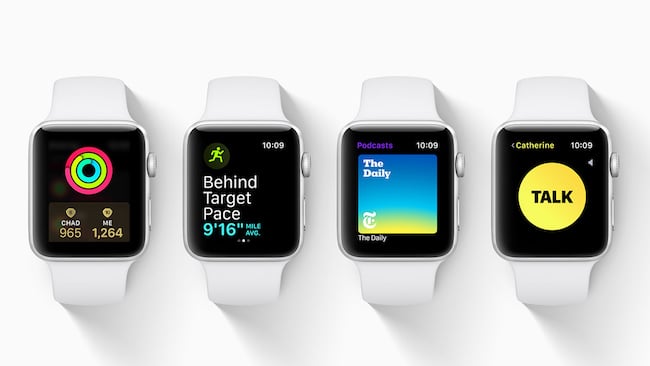
The new WatchOS 5 marks a turning point for the original Apple Watch, which will no longer be supported by the new update
watchOS 5
There were two key themes for the new watchOS: staying active and being connected.
In the former, we got a fun new 7-day competition with friends option, new workouts such as yoga, plus enhanced existing workouts such as running with pace alerts, cadence and more. Most welcome for existing users was the ability to auto-detect workouts starting and even retroactive recognition for calories earned in a workout you’d forgotten to trigger.
For connected, we had a fun ‘walkie-talkie’ mode - which had previously been shown but not released. Netflix’s Stranger Things may make it more attractive this time around.
Siri Watch face has been enhanced to support Siri Short Cuts, which means third party app integration, plus ‘Hey Siri’ is no longer needed to access Siri - simply raising the watch to your face will do.
One other thing to note, the new watch OS won’t run on the original Apple Watch which was retroactively dubbed Series 0 by Apple to implicitly denote its limited processing power.
Wrap-up
WWDC18 has been dismissed as something of a snooze fest lacking in exciting features and hardware. In a professional environment, however, there’s a need for reliability and stability that many feared Apple was losing by constantly chasing glitzy new features. Early feedback on developer betas is already encouraging for stability, so this might be a very useful course correction ahead of the 2019 Mac Pro and iOS to Mac apps which could significantly freshen up the Mac platform.
Tags: Technology


Comments